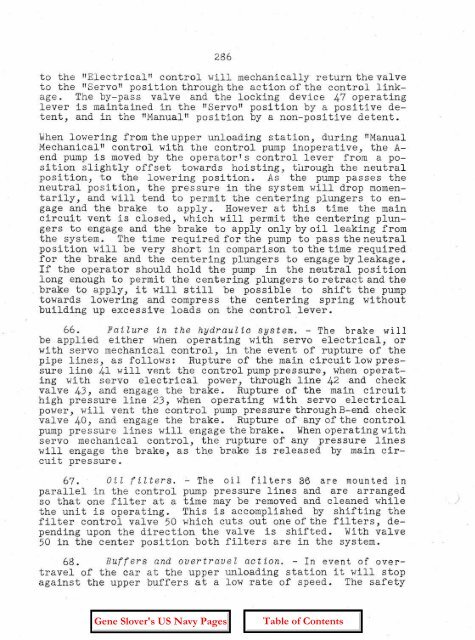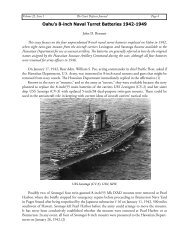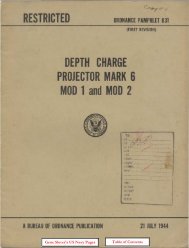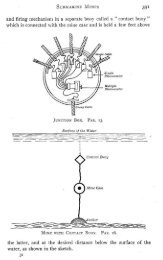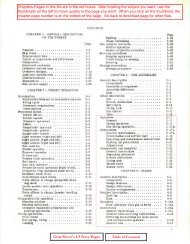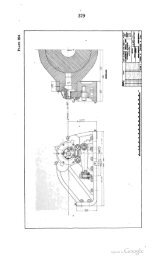OP-755 Part 2 Pages 197-401 - Personal Page of GENE SLOVER
OP-755 Part 2 Pages 197-401 - Personal Page of GENE SLOVER
OP-755 Part 2 Pages 197-401 - Personal Page of GENE SLOVER
You also want an ePaper? Increase the reach of your titles
YUMPU automatically turns print PDFs into web optimized ePapers that Google loves.
286<br />
to the "E'Lec t.r-Lc aL" control will mechanically return the valve<br />
to the ItServolt position through the action <strong>of</strong> the control linkage.<br />
The by-pass valve and the locking device 47 operating<br />
lever is maintained in the ItServol1 position by a positive detent,<br />
and in the ItManuall1position by a non-positive detent.<br />
when lowering from the upper unloading station, during "Manual<br />
Mechanical" control with the control pump inoperative, the Aend<br />
pump is moved by the opera tor I s control lever from a posi<br />
tion slightly <strong>of</strong>fset towards hoisting, t.ur ough the neutral<br />
position, to the lowering position. As the pump passes the<br />
neutral position, the pressure in the system will drop ~omentarily,<br />
and will tend to permit the centering plungers to engage<br />
and the brake to apply. However at this time the main<br />
circuit vent is closed, which will permit the centering plungers<br />
to engage and the brake to apply only by oil leaking from<br />
the system. The time required for the pump to pass the neutral<br />
posi tion will be very short in comparison to the time required<br />
for the brake and the centering plungers to engage by leakage.<br />
If the operator should hold the pump in the neutral POSltion<br />
long enough to permit the centering plungers to retract and the<br />
brake to apply, it will still be possible to shift the pump<br />
towards lowering and compress the centering spring without<br />
building up excessive loads on the control lever.<br />
66. Fa i lure in the hydraul i c system. - The brake will<br />
be applied either when operating with servo electrical, or<br />
with servo mechanical control, in the event <strong>of</strong> rupture <strong>of</strong> the<br />
pipe lines, as follows: Rupture <strong>of</strong> the main circuit low pressure<br />
line 41 will vent the control pumppressure, when operating<br />
with servo electrical power, through line 42 and check<br />
val ve 43, and engage the brake. Rupture <strong>of</strong> the main circuit<br />
high pressure line 23, when operating with servo electrical<br />
power, will vent the control pump pressure through B-end check<br />
val ve 40, and engage the brake. Rupture <strong>of</strong> any <strong>of</strong> the control<br />
pump pressure lines will engage the brake. Whenoperating with<br />
servo mechanical control, the rupture <strong>of</strong> any pressure lines<br />
will engage the brake, as the brake is released by main circuit<br />
pressure.<br />
67. Oil filters. - The oil filters 36 are mounted in<br />
parallel in the control pump pressure lines and are arranged<br />
so that one filter at a time may be removed and cleaned while<br />
the unit is operating. This is accomplished by shifting the<br />
filter control valve 50 which cuts out one <strong>of</strong> the filters, depending<br />
upon the direction the valve is shifted. With valve<br />
50 in the center pOSition both filters are in the system.<br />
68. Buffers and ou er t r au e i action. - In event <strong>of</strong> overtravel<br />
<strong>of</strong> the car at the upper unloading station it will stop<br />
against the upper buffers at a low rate <strong>of</strong> speed. The safety


